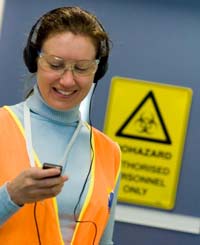Tour of Duty
This new training system seeks to engage the learner through the use of next-gen narration.
- By Marc Barrera
- Mar 01, 2008
 The Chinese philosopher Confucius
once said, “I hear and I forget. I see
and I remember. I do and I understand.”
This ancient proverb seems even more
appropriate when dealing with safety and
safety training. So many choices are available—
including audio, video, written
materials, and personal instruction. The
Australia-born VoiceMap™ system created
by behavioral scientist Maggie
Haertsch, Ph.D., combines all of these
elements into one to deliver a customized
training program that not only instructs
trainees, but also gets them actively
involved in the lesson.
The Chinese philosopher Confucius
once said, “I hear and I forget. I see
and I remember. I do and I understand.”
This ancient proverb seems even more
appropriate when dealing with safety and
safety training. So many choices are available—
including audio, video, written
materials, and personal instruction. The
Australia-born VoiceMap™ system created
by behavioral scientist Maggie
Haertsch, Ph.D., combines all of these
elements into one to deliver a customized
training program that not only instructs
trainees, but also gets them actively
involved in the lesson.
Assessing a Baseline
To start, new employees must first take an
online pre-test. This serves several purposes,
the most important of which is to
prime the new employees for the lessons
to come and to find a baseline from which
to measure their progress. “It sensitizes
them to the information that they’re getting,
and it’s actually a fair way of assessing
people,” said Haertsch, adding that the
baseline assessment can also be an important
tool toward ensuring new hires have
the necessary and sometimes critical job
qualifications that some industries, such as
health care, might require.
“When they’re working in an environment,
regardless of whether they’re new
to that environment, it’s expected of them
to know certain things. Say, for instance,
working with drug calculations. These
are professional skills for nursing and
medical staff, and if they are scoring too
poorly on a pre-test, you would be concerned
about some elements of their
competency,” she said.
After completing the pre-test, new
hires are given an iPod to start their audio
training tour. However, rather than sit in
front of a computer, the trainees walk
through the facility as audio instructions
prompt them to perform certain actions at
various locations. Before entering each
location, the trainee is instructed on the
necessary safety procedures and protocols
to take, such as the appropriate protective
equipment to put on and for
which hazards to be on the lookout.
3-D animations or videos will display
on the iPod at certain parts of
the tour to better illustrate certain
aspects of their training. As an
example, Haertsch said, this capability
could be used to better illustrate
proper operation of equipment
that employees may use when performing
their duties. “To help
someone understand a piece of
equipment, we can model-up the
equipment so that they can be
looking and feeling and playing with
the equipment in front of them as
well as checking that they understand
exactly what is being instructed
by looking at the screen,” she said.
This capability doesn’t stop with
hands-on instruction. Haertsch said
video of a past incident or a 3-D recreation
can be shown to the trainees when
they reach the place of occurrence as the
audio explains “exactly how that incident
happened and the lessons learned from
that, as a way of improving their hazard
recognition and improving their safety
behaviors.”
After completing the instructional
tour, trainees complete another online test
that serves the dual purpose of ensuring
the information has been retained and the
training method of delivery was effective.
“You can always assess its effectiveness,”
Haertsch said. “You would be concerned if
you weren’t seeing an increase on the
post-test scores. There could be an issue
in the way in which the message is delivered.
So it’s a great way of doing a quality
check on what you’re doing.”
Out with the Old, in with the New
Effective delivery and retention are the
goals of the VoiceMap system. “The technique
engages the learners in their work
environment and uses visual triggers
around that environment to help them
create a memory,” she said. One aspect
that is particularly useful for today’s global
economy, Haertsch said, is the program’s
ability to be created in any language for
use in any country, complete with the
appropriate regional accent, thus ensuring
that a uniform training program is implemented
across a company’s many locations.
“Anyone sitting around a board
room would feel very reassured with this
type of system because it’s ensuring that
the policy that’s created in the boardroom
is actually delivered to the front-line staff,”
she said. Also, companies can further personalize
and reinforce leadership in their
organization by having CEOs, managing
directors, and others recorded into the
program. This is especially useful in preserving
the on-the-job experience that
may be lost when new workers replace
older ones as long-term employees reach
retirement age. “This is the perfect way of
capturing their knowledge and experience
and being able to deliver that back in a
format that really sits well with the next
generation coming through,” she said.
For more information or to view
online demos, visit www.voicemap.net.
This article originally appeared in the March 2008 issue of Occupational Health & Safety.